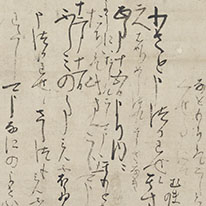Past Exhibitions
- Feature Exhibition; Hidden Treasures from a Merchant’s Storehouse:
The Hiromi Collection, a Legacy of Elegant Living
Part II: Chanoyu and Sencha Tea Ceremonies - February 3, 2018 - March 18, 2018
The Hiromi family is an old merchant family in the city of Kaizuka, in Osaka (not far from Kansai Airport). Their family business, established in 1835, was a shipping brokerage (kaisen don'ya) for the rice trade. Thereafter, they added a variety of other divisions including fertilizer, stock investment, and bank management, which not only grew the family assets but also contributed to the development of modern industry in the region. Their spacious estate includes a 34 meter-wide machiya, a tea house, and four earthen storehouses (kura) filled with a vast treasure trove of artworks—painting and calligraphy, tea utensils, furnishings, and other luxurious objects. These long hidden treasures, including works by Itō Jakuchū, Shiba Kōkan, Shibata Zeshin, and others, have been discovered in recent years and donated to the Kyoto National Museum for preservation, study, and exhibition to the public.
Part II: Chanoyu and Sencha Tea Ceremonies
One of the four storehouses on the Hiromi property was filled with precious utensils for the ritual preparation of tea. Most of these were collected from the end of the nineteenth century up through the prewar years by the fourth generation head of family. He did not generally spend vast sums of money to acquire famous masterworks; instead, he focused on carefully selected pieces for his practice of chanoyu, the Way of Tea, or for the ritual preparation of sencha—steeped, roasted green tea leaves served in miniature, Chinese-style teapots and cups.
This section of the exhibition envisions the utensils used at such tea gatherings: a tokonoma alcove hung with a segment of the Meigetsuki diary of courtier Fujiwara Teika (1162–1241), a letter from warlord Toyotomi Hideyoshi (1537–1598), or a bamboo shoot painting by Itō Jakuchū (1716–1800). Perhaps tea sweets would be served on individual trays made by renowned lacquer artist Shibata Zeshin (1807–1891).












